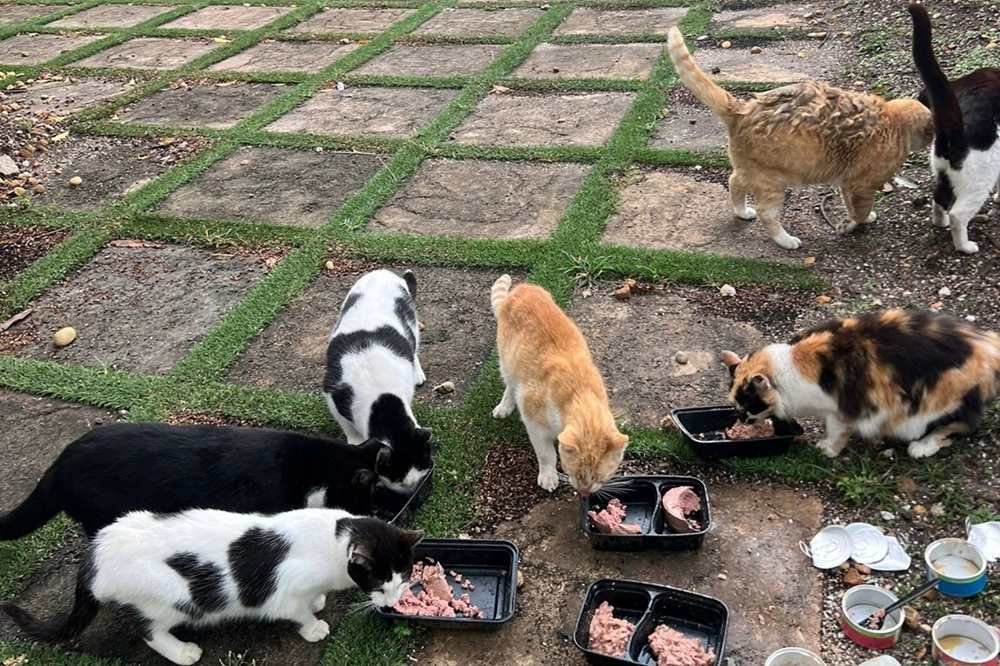
Kirsten McCarthy / Cats.com
Unfortunately, most shelters are already at capacity and strapped for resources. This makes it difficult to provide adequate care and permanent homes for all of the kittens born during this time of year. There’s no easy answer to the challenges introduced by kitten season. But as I learned from two shelter representatives, there are ways to help.
Here’s why kitten season happens, how it impacts rescues, and how we can all lend a hand.
What Is Kitten Season?

From late March through October, we see a surge in kitten births. Kirsten McCarthy / Cats.com
Spring signals mating season for cats across North America. This is tied to a boost in survival odds thanks to the longer days, warmer temperatures, and easier access to food. The exact timeline varies depending on geographic location. In regions where the climate is mild year-round, the feline breeding season may be a yearlong event. What’s more, there’s evidence that climate change is contributing to a kitten season that comes earlier and lasts longer.
Feline biology further complicates things. Cats can reach puberty and become pregnant at just 4–6 months old. Once they’re fertile, they go through multiple heat cycles during the breeding season. Because cats’ gestation period is just a few months long, they can have several litters in succession. Additionally, cats don’t experience menopause, so they can continue to get pregnant in their senior years.
On average, cats give birth to litters of four to six kittens. With the possibility of multiple litters per season, it’s easy to see how overpopulation can quickly spiral out of control. Cats represent an overwhelming majority of the animals at shelters in the United States. According to data collected by the Humane Society of the United States, about 3.2 million cats enter shelters every year. Tragically, 58% are euthanized.
The Impact of Kitten Season on Shelters

Most shelters are overwhelmed by an influx of kittens in the spring, which strains resources and staff. Kirsten McCarthy / Cats.com
The fallout from kitten season hits animal shelters especially hard. Taking care of kittens is a labor-intensive task, particularly for orphaned newborns. These fragile youngsters are susceptible to illness and require frequent bottle-feeding and attention. Most shelters struggle to provide this level of care.
For Kerry Neaf, a foster coordinator at the City of Buffalo Animal Shelter, the biggest challenge of kitten season lies in finding enough foster homes for all the litters that are too young, too sick, or too shy to be placed up for adoption. “Shelters are not great places for young kittens whose immune systems aren’t fully developed,” Neaf points out. “We rely on our wonderful volunteer foster homes to get them healthy and ready for adoption.”
This experience is echoed by Kimberly LaRussa, a representative at Ten Lives Club, a no-kill cat adoption group in Western New York. And yet, the extra pressure has given way to some resourceful solutions.
“We start preparing for kitten season two to three months in advance,” says LaRussa. “We even host our own ‘Kitten Shower’ to get ready for the season. It’s like a baby shower but for kittens!” La Russa explains that supporters can donate the supplies they’ll need to get through the season. This includes items like heating pads, kitten food, litter supplies, and blankets.
Kitten season has consequences for adult cats too. “When we have a lot of kittens available, it makes it tougher for our adult cats to find homes,” says Neaf. “They can’t compete with the cuteness of all the babies!”
How You Can Help

Volunteering to bottle-feed kittens is one of the many ways you can help. AG-PHOTOS / Shutterstock.com
If this tugs at your heartstrings, there are lots of ways to help. Whether it’s time, money, or ___, everyone can provide some relief to animal welfare groups during kitten season.
Adopt a Cat of Any Age
If you’ve been thinking about adding a kitten to your family, this is the perfect time to do so. You’ll be saving a life while easing some of the burden on your local shelter. Adopting a kitten from a shelter has its advantages—financially and otherwise.
“It’s good to remind people that the ‘free’ kittens they may see advertised aren’t really free in the long run,” explains Neaf. “Sure, there’s a fee to adopt; but your kitten from us will come altered, with age-appropriate vaccines, feline combo tested, flea-treated, dewormed, microchipped, with a free vet visit, and a bag of food for just $110.” That’s less than most kittens’ first vet visit alone!
And don’t forget the adult and senior cats! These sweet cats have tons of love to give and are likely to be overlooked during kitten season.
Consider Fostering
Fostering a kitten (or six) may be a better alternative if adoption is too much of a commitment. According to Neaf, fostering is one of the most important ways people can help. It can also help you determine if adoption might be in your future.
Shelters depend on volunteer foster families to provide a safe and healthy environment for kittens until they are ready for adoption. If you’re able, consider fostering multiple cats or a whole litter to help with their socialization.
Make a Donation
“Monetary donations are always helpful because a large percentage of the kittens that come to us have respiratory or digestive ailments that require veterinary treatment and medication that we pay for,” says Neaf. She adds that shelters also go through a lot of kitten food and other supplies.
Check with your local organizations to see what items they need most. Many shelters could use extra litter, food, bedding, and toys. They also need kitten-specific tools like miracle nipples for syringe feedings. Many organizations have wishlists on Amazon or Chewy, so you can donate exactly what they need and have it shipped right to them.
Volunteer Your Time and Skills
Time is another valuable resource that’s in short supply. If you have time to spare, consider volunteering at a local shelter. LaRussa tells us that people can help with tasks like cleaning, hosting a fundraiser, or acting as a bottle feeder for orphaned kittens. Sign me up!
If you have unique skills that may be useful to a non-profit organization, offer to donate your time. Many shelters can use help maintaining their website, organizing PR events, or doing landscape work around their building.
No time at all? Help spread awareness with a few clicks. Follow your local shelters and rescue groups on social media so you can like and share their events and requests.
Get Involved in TNR Efforts
Trap-neuter-release programs are a humane way to keep free-roaming cat populations under control. Some shelters have TNR programs that welcome volunteers willing to help safely trap cats and transport them to the vet for spaying and neutering.
If you know of a colony of community cats, this could be a great opportunity to help keep their numbers down. Many of these TNR groups and experts have a social presence on Instagram or Facebook. Contact them for ways you can help.
And finally, don’t forget your own pets. “You can also help alleviate the overpopulation problem by spaying and neutering your pets,” says LaRussa.
Stray Kittens and Pregnant Cats

If you find stray kittens, don’t rush to intervene—unless they’re in danger, wait and watch, as their mother is likely nearby gathering food. Melina Grin / Cats.com
If you come across what appears to be an abandoned kitten or litter of kittens, resist the urge to intervene right away. Kittens under eight weeks of age are better off under the care of their mother and there’s a good chance she’s out hunting for food. Unless the kitten is injured or in immediate danger, it’s advisable to wait a few hours and see if the mother cat returns.
If the mom comes back and the area appears safe, it’s best to leave the kittens with her. You can offer her food and keep an eye on the little family. When the kittens reach eight weeks, you can contact a TNR program. At this age, kittens will be playful, more coordinated, and have bright eyes and some teeth.
If the mother does not return, and the kittens appear to be under eight weeks of age, they need help. You can contact an area rescue center, shelter, or veterinary clinic for assistance.
However, if you find a stray cat that is visibly pregnant, she probably needs some assistance. If you can safely collect her in a pet carrier or box, you can take her to your vet to see if she is microchipped. Ask your veterinarian or local shelter for recommendations on next steps. They will advise on caring for the mom and kittens and schedule the mom’s eventual spay surgery.
Frequently Asked Questions
Is TNR actually effective?
Many animal welfare organizations are advocates for TNR efforts, including the American Veterinary Medical Association (AVMA), the American Society for the Prevention of Cruelty to Animals (ASPCA), and the Humane Society of the United States (HSUS). Numerous published case studies have shown that TNR can successfully reduce colony sizes over time.
Can you keep a stray kitten?
If there’s evidence that the mother is still present, it’s better to leave the kitten alone. The same goes for kittens over four months, who will struggle with socialization and are better left outdoors. But if you’re sure the kitten is abandoned, and you’re clear about the responsibility and commitment of raising a young kitten, offering it a safe home may save its life.
How can you tell how old a stray kitten is?
There are a few telltale signs to watch for. Newborns under a week will have closed eyes and folded-down ears. You may even notice an umbilical cord still attached. By week two, their eyes are beginning to open and their ears start to unfold. At three weeks, their eyes and ears are fully open, and baby teeth begin to emerge. Between four to five weeks, kittens become playful, and at eight weeks they will look like mini cats weighing around 900 grams and measuring 10 inches long.
-
Kitten season. (n.d.). The Humane Society of the United States.
-
Pets by the numbers. (n.d.). The Humane Society of the United States.
-
Community Cat Trap-Neuter-Vaccinate-Return (TNVR) success Stories. (n.d.). Best Friends Animal Society.
-
Neaf, K. (2024) Personal interview.
-
LaRussa, K. (2024) Personal interview.







